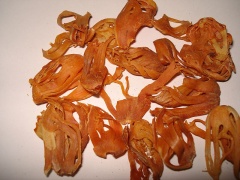Difference between revisions of "Mace"
| Line 22: | Line 22: | ||
==Risk factors== | ==Risk factors== | ||
- Self-heating / Spontaneous combustion<br> | - Self-heating / Spontaneous combustion<br> | ||
| − | - Moisture | + | - Moisture<br> |
- Odor<br> | - Odor<br> | ||
- Contamination<br> | - Contamination<br> | ||
Revision as of 08:12, 26 June 2012
| Infobox on Mace | |
|---|---|
| Example of Mace |  |
| Facts | |
| Origin |
|
| Stowage factor (in m3/t) |
|
| Humidity / moisture |
|
| Oil content |
|
| Ventilation | If the product is at "shipping dryness", it does not have to be ventilated during transport. However, if the water content does not meet these guidelines, 6 air changes/hour (airing) are recommended to eliminate the potential for dampness. |
| Risk factors | An elevated moisture content and excessively high temperatures create a risk of self-heating. Sensitive to wet damage. |
Mace
Description
The nutmeg tree is important for two spices derived from the fruit: nutmeg and mace.
Nutmeg is the seed of the tree, roughly egg-shaped and about 20 to 30 mm long and 15 to 18 mm wide, and weighing between 5 and 10 g dried, while mace is the dried "lacy" reddish covering or aril of the seed. The first harvest of nutmeg trees takes place 7–9 years after planting, and the trees reach full production after 20 years. Nutmeg is usually used in powdered form. This is the only tropical fruit that is the source of two different spices. Several other commercial products are also produced from the trees, including essential oils, extracted oleoresins, and nutmeg butter.
The common or fragrant nutmeg, Myristica fragrans, native to the Banda Islands of Indonesia, is also grown in Penang Island in Malaysia and the Caribbean, especially in Grenada. It also grows in Kerala, a state in southern India. Other species of nutmeg include Papuan nutmeg M. argentea from New Guinea, and Bombay nutmeg M. malabarica from India, called jaiphal in Hindi; both are used as adulterants of M. fragrans products.
Postharvest air-drying renders mace hornlike, brittle and waxy. In its commercial forms, mace is pressed flat and dried or ground.
Applications
Nutmeg and mace have similar sensory qualities, with nutmeg having a slightly sweeter and mace a more delicate flavour. Mace is often preferred in light dishes for the bright orange, saffron-like hue it imparts. Nutmeg is used for flavouring many dishes, usually in ground or grated form, and is best grated fresh in a nutmeg grater.
Shipment/storage
Mace is shipped in cases or bags. The favourable travel temperature range is 5 – 25°C. At temperatures >25°C, essential oils may be lost. The stowage space should be cool, dry and, most particularly, easy to ventilate.
Mace is hygroscopic and thus interacts with the moisture in the air. Mace having excessive moisture damage will become mouldy and odorous; this leads to considerable depreciation. If not subjected to excessive moisture, moulds and discolouration may be reduced or removed by exposure in thin layers to the air and sun. After drying the mace may become brittle with loss of value. If mace has been wetted and can be dried and handled within a reasonable time, there should be no loss in quality, but handling tends to break the mace and may alter its grade value.
Risk factors
- Self-heating / Spontaneous combustion
- Moisture
- Odor
- Contamination
- Mechanical influences
- Toxicity / Hazards to health (mould growth / aflatoxin)
- Shrinkage/Shortage
- Insect infestation / Diseases
Note: Source including Transport Information Service of the GDV











